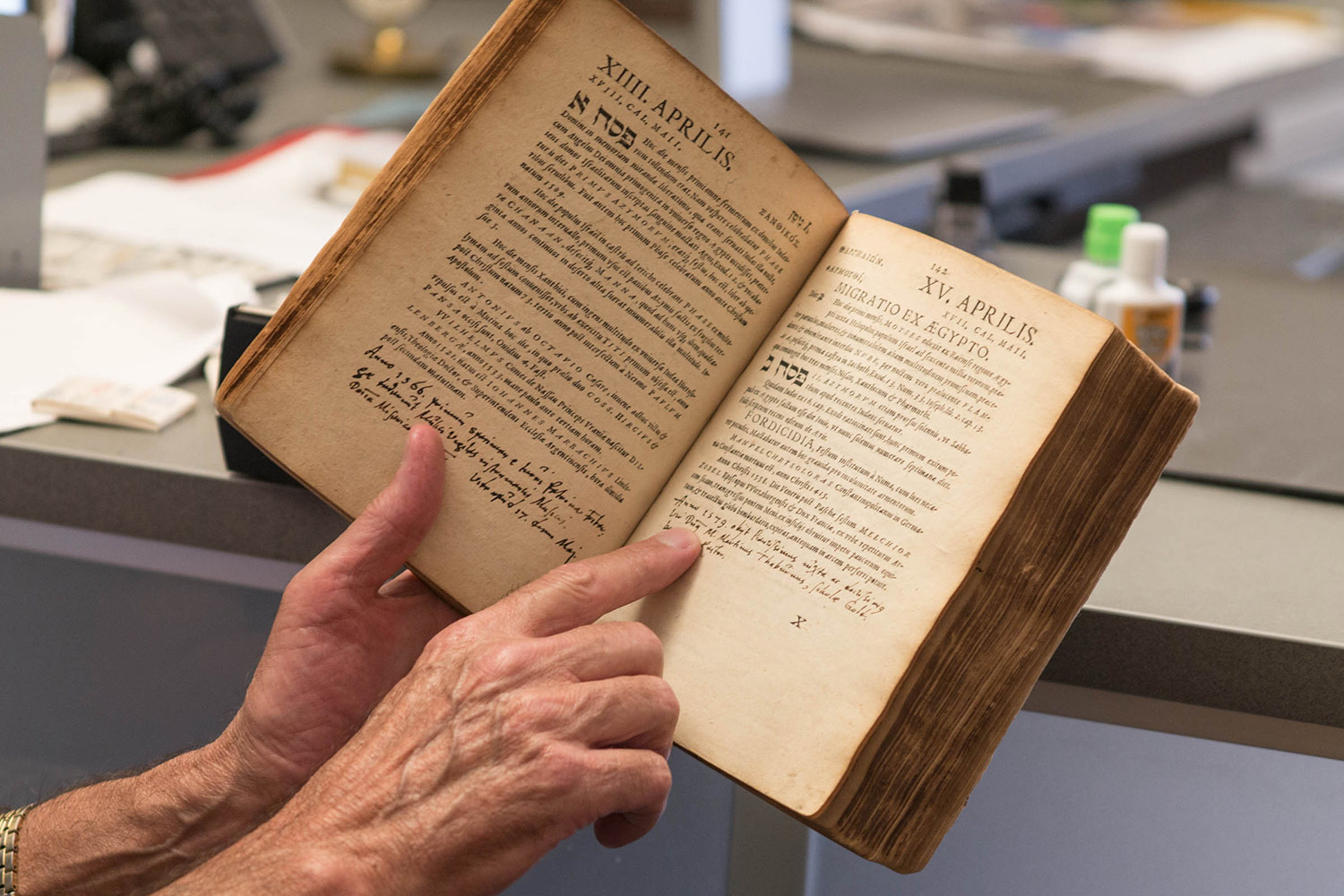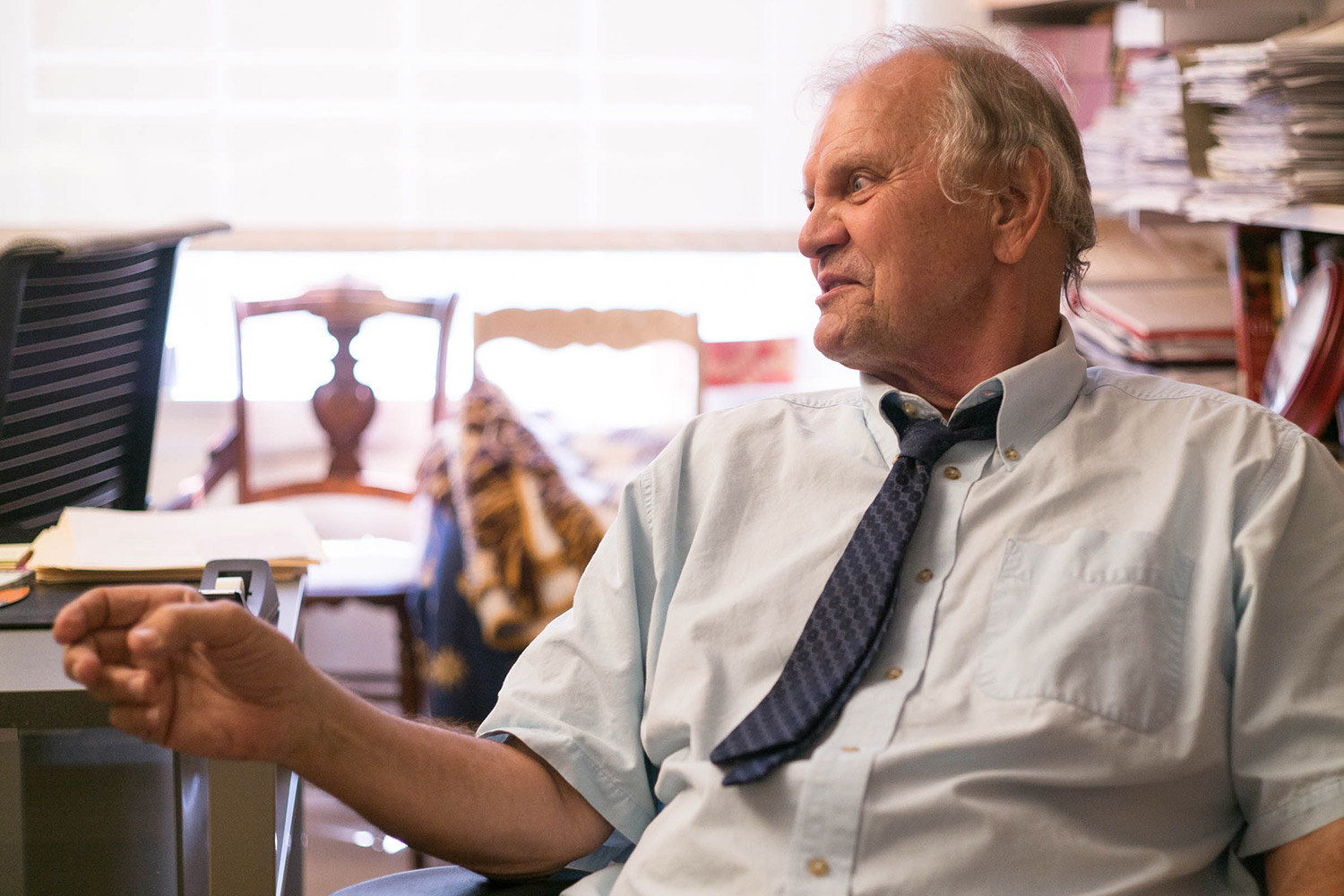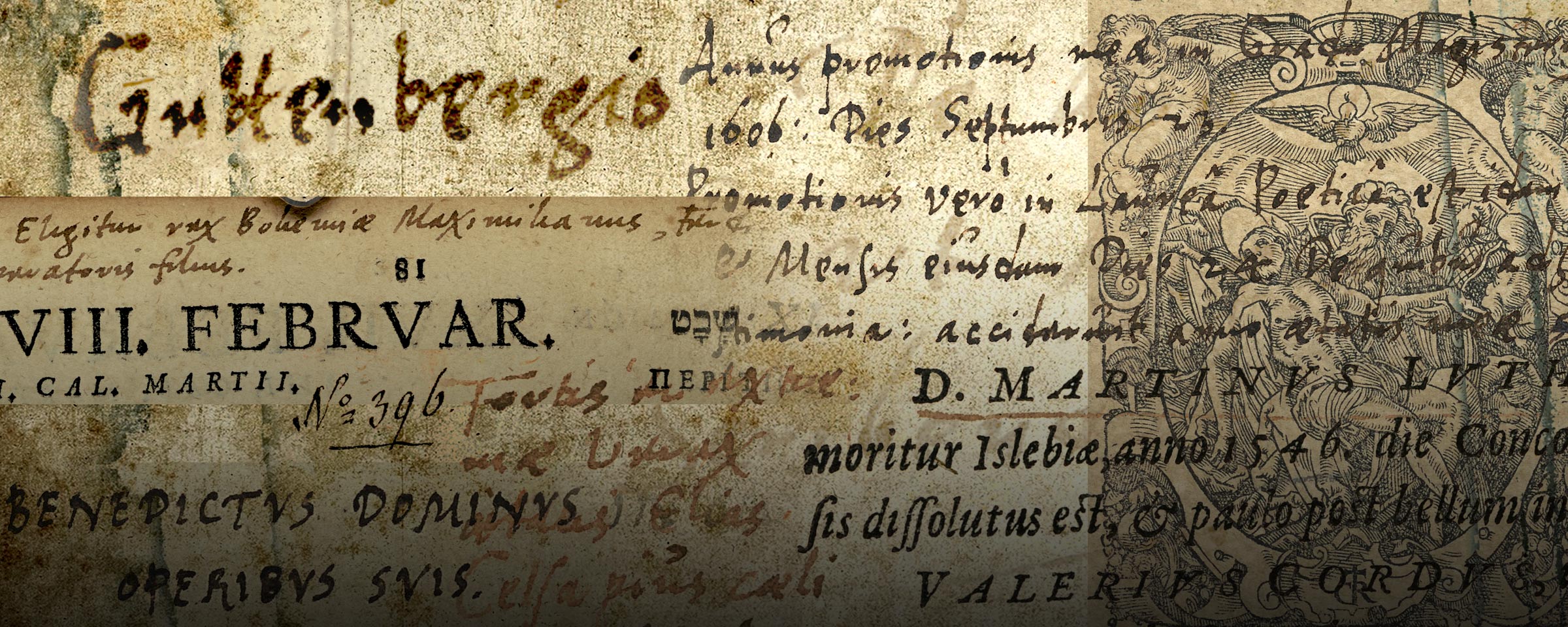For many years, a 16th-century daybook sat mostly undisturbed on a bookshelf in William McDonald’s office. Thinking he’d bought a dud, the University of Virginia professor of German filed it away shortly after purchasing it in the 1980s. It wasn’t until three decades later that he realized he’d been holding on to a fascinating window into history.
“It cost me $50 – and that was a lot of money then – but I decided to spend it because I thought the book had belonged to Georg Agricola, the famous German metallurgist,” he said.
It turned out that this book belonged to a different Georg Agricola, a Lutheran pastor in Freiberg, Germany. Furthermore, Agricola’s scrawling handwriting made his notes in Latin difficult to decipher.

Miller points out Agricola’s personal additions to the printed summary of events inside the daybook. (Photos by Sanjay Suchak)
Disappointed, McDonald put the book out of his mind – until a few years ago, when a graduate student suggested they make a project out of trying to translate it. That’s when he found a fascinating reference to Johann Gutenberg, long described as the inventor of the printing press.
“We were shocked that there would still be a controversy about the invention of the art of printing just over a century after it happened,” said McDonald.
Inside the front cover, Agricola had written out his own internal debate about whether or not Gutenberg should be given credit for the invention of the movable type printing press in the 1450s.
“It’s very surprising that a German intellectual – a highly educated pastor who has such a great command of the classics that he keeps his personal notes in Latin prose and verse – was still asking this question,” McDonald said.
Driven to get a better look into Agricola’s mind, McDonald reached out to John Miller, UVA’s Arthur F. and Marian W. Stocker Professor of Classics.
“My Latin is OK, but John is a master,” he said.
Miller also specializes in the history of the calendar, so he was interested to see Agricola’s written additions to the historical dates printed in his daybook. The book itself was one of many copies printed of Paul Eber’s popular “Calendarium Historicum.” Agricola owned the 1573 edition and wrote in it from about 1578 to 1622.
“Part of the challenge was just reconstructing his handwriting, just paleography and making sure that we had the correct transcription and then translating it from the Latin,” Miller said.
Agricola writes in neo-Latin, a scholarly form of Latin used long after it was a regularly spoken language, and his distinct 16th-century-style German handwriting makes it all the more difficult to read.
Working together, the professors were able to decipher Agricola’s arguments for and against Gutenberg as the inventor of the printing press. At the conclusion of his notes, Agricola surprised them further by concluding that the credit should go to the printing partners Johann Fust and Peter Schöffer, and not Gutenberg.
Agricola’s personal musings on the subject will not challenge the overwhelming amount of historical evidence in favor of Gutenberg as father of the printing press, but his notes are important to researchers studying German history and the history of printing.
McDonald and Miller shared their findings with researchers at the Gutenberg Society in Mainz, Germany, the city forever associated with Gutenberg and his innovations. They’ve also written an article on their research, “Ars imprimendi libros initium cepit: Remarks of a Lutheran Pastor, Georg Agricola (1554-1630), Concerning the Origin of the Art of Printing in Mainz,” and it appears in the current issue of the preeminent periodical on Gutenberg research and the history of the art of printing, the Gutenberg-Jahrbuch.
“It’s rare to find some early document that talks about Gutenberg, so the society was quite excited,” McDonald said.

German professor William McDonald explains his excitement upon finding the Gutenberg reference.
Agricola’s writings also provide a rare glimpse into the life of a prominent Protestant minister during the Reformation. Each page in the daybook has printed descriptions of the feast days and important historical moments that occurred on that day. It includes dates from antiquity as well as markers of Protestant, pagan and Jewish traditions, but it is based primarily on the traditional ecclesiastical calendar.
“‘Ecclesiastical’ previously meant the Catholic year, but this is a Protestant calendar. So the great figures of the Protestant movement – Luther in particular – will be inserted into it,” Miller said. “During the Reformation, we see where current history is inserted into longer-standing historical narratives and even Catholic Church history is being rewritten. We can see it happening at the micro-level here.”

Classics professor John Miller explains the difficulties of deciphering neo-Latin written in German handwriting.
Agricola adds his own thoughts below the pre-printed dates of importance and inserts his descriptions of important days in the early Protestant movement as well as contemporary German society. His lengthy comments surrounding the date of Luther’s death (Feb. 18, 1546) are an example of the extreme reverence shown to the Reformation leader by his contemporaries.
“It’s a personal reaction to history. It’s a look into his mind and we think it’s a treasure trove. We want to share it,” McDonald said.
McDonald and Miller teamed up with the UVA Library’s Digital Production Group to digitize the manuscript and make it available to scholars around the world. The group has recently finished the full digitization and will be uploading it to the library’s Virgo database later this summer.
Miller and McDonald are looking forward to all the ways the clear digital images will allow them to expand their research and open new opportunities for student collaboration. They would like to use the book as a way to spur interdisciplinary seminars where history, religious studies, German and classics students could work together researching it.
“I think it’s really important that senior professors in the fields of humanities work together. Combined, John and I have 72 years of teaching experience at UVA,” McDonald said. “We talk about cross-disciplinary work all the time. That’s the buzzword, but this is an example of what can happen when people do it.”
Media Contact
Article Information
July 11, 2016
/content/reformation-era-daybook-challenges-gutenbergs-place-history-0

